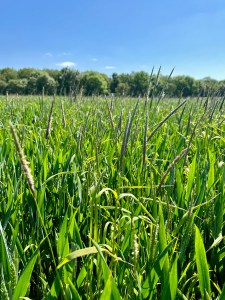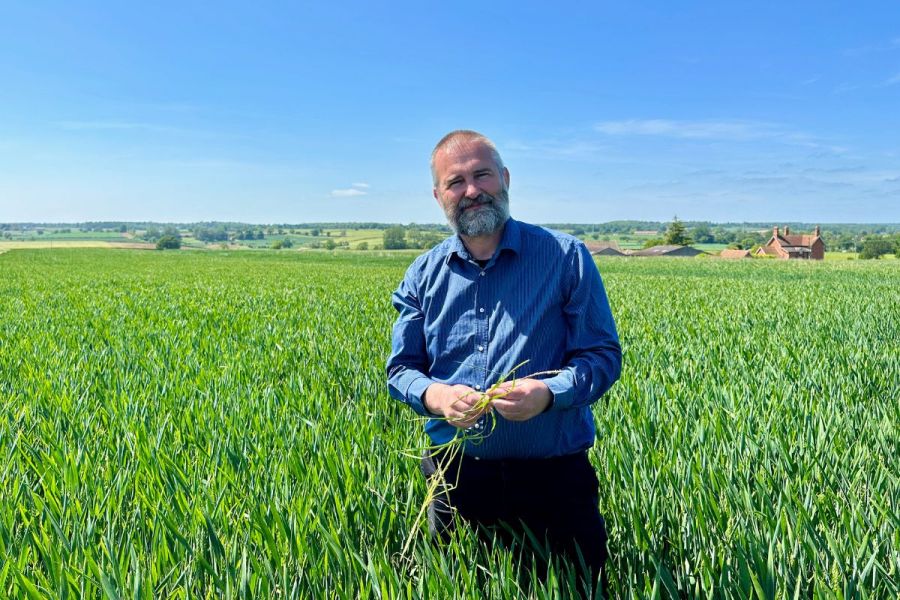There’s no disguising the fact that grassweed control isn’t as good as it should be in some fields this summer. CPM attends a BASF briefing to hear why it’s been a difficult season and the lessons that can be drawn from it.
“If each surviving plant is producing 30 or 40 tillers, the maths is against you as much as the biology.”
By Mike Abram

A lack of canopy suppression has meant that vegetative weed control hasn’t translated to seed head control.
As ears wave in the June sunshine, driving around the country it’s evident that grassweed control wasn’t as successful as some growers might have hoped.
Variability in control has been the key feature of the season, notes NIAB weed biology and management specialist, John Cussans. “All of the key elements that drive variability of success for grassweed control have been at play.”
He explains that some of the elements which lead to variable control are baked into most growers’ situations: herbicide resistance, particularly of contact-acting grassweed herbicides, which means a lot of in-season activity has been lost and the weed burden in seedbanks is high.
“Classically, we haven’t thought about how higher population levels are harder to control than lower populations because we had contact-acting herbicides,” notes John.
But reliance is now much more on controlling weeds using autumn-applied residual chemistry, when any survivors from a weed seedling population will be higher when the seedbank population is big, he adds.
“Large weed seeding populations aren’t reducing efficacy, but they do compromise successful control from herbicides in terms of seed return.”
Pre-emergence efficacy drops in autumn-sown crops when conditions are dry, or where there’s high sunlight intensity and high degradation of the herbicide. One of the drivers of the success of later drilling is an environment where pre-ems work better, explains John
Another reality of weed management is that timing herbicide applications in the field is not always easy to achieve, while higher loadings of residual herbicides can impact on crop safety, reducing the competitive nature of the crop.
Crop suppression during the season is another factor that can drive variability in successful control. “It’s something we take for granted to some extent. One of the things we’re seeing this year is, that even where we’ve had relatively good success in the autumn, a lack of canopy suppression has meant that weed control hasn’t translated to head control because the crop isn’t helping to finish the job,” he explains.
A perfect storm has meant all of those factors occurred at some point during the season. In September there was a prolonged period of low or no rainfall before drilling, so there was a poor chit of freshly shed weed seeds, leading to an inability to make a stale seedbed approach work effectively.
The dry conditions also hampered seedbed preparation and there were problems drilling seeds to the required depth to minimise crop safety issues when following with a pre-em. Dry soils are also not optimal for residual herbicide performance.
When the weather broke in late September or October, there was immediately a flush of grassweeds, which for some would have come in the crop post-drilling. For others the break in the weather meant conditions made drilling tricky, and difficulties with herbicide affecting crops vigour, or even thinning crops in places, explains John.
“We had virtually every possible combination of situation from relatively low populations and good herbicide efficacy to apocalyptic levels of blackgrass and poor herbicide control. Some growers actually saw levels of control go backwards during the season.”
Weather again played a part in that, he says. “In late January and particularly February, it was dry, which meant just as you wanted the crop canopy to take off and smother weeds, it didn’t.
“If each surviving plant is producing 30 or 40 tillers, the maths is against you as much as the biology.”
The final nail in the coffin was the wet March and April, making it hard to find an application window for spring applied herbicides. “That might be why we’re seeing an uptick in brome and Vulpia (fescues) levels.”
So what does that mean for the coming season? First, with variability in success at both farm and field level, there should be a big focus on risk management, he suggests. “Map out where the higher-pressure areas are and think about field history to tailor weed management, such as drilling dates and herbicide packages.
“If you haven’t used inversion tillage in a field for a while and you’ve had an outbreak year, for example with brome, think about using the plough as a reset. Stop saving the planet and save yourself – this is the tool you’ve been keeping in reserve for when the weed pressure is greatest on farm.”
But if you do plough, make sure it’s in conditions where you get good soil inversion to maximise effectiveness, he stresses.
John highlights that good risk management will also tailor sowing dates and herbicide programmes to weed pressure and recognise that some fields aren’t suitable for winter cropping this autumn.
Secondly, John suggests there should be a bigger focus on how to make crop canopies more suppressive, especially during rapid growth in the spring. “There’s an increasing frequency of springs where crops are subject to stress when they should be rapidly growing to help finish the work of pre-em herbicides.”
Low disturbance establishment on wider row spacings, although a net positive for weed control through the rotation, might be exacerbating the problem for crops stressed in the spring by creating a more open canopy, he says. “They bring slightly different challenges around getting a suppressive crop canopy and also making sure there’s good even coverage of drilled seeds, even where drills have individually articulated coulters which are slightly more vulnerable to lack of seed depth.”
Lastly, John reminds growers that doing nothing straight after harvest is a valid option. “If it’s very dry, the optimum to reduce the impact of freshly shed grassweed seeds is to do nothing. It requires a little more bravery to use the natural degradation of these seeds, especially if you’re using a low disturbance system.”
Most growers and experts believe that the more blackgrass seedlings that emerge before drilling, the less will emerge in the crop, says John. But he points to some old AHDB research that shows it’s only true in wet conditions, when cultivation or management strategies to encourage germination may be effective. In drier conditions, the research showed where low numbers of blackgrass seedlings emerged before drilling, lower levels also emerged in the crop.
“In dry conditions, leaving seed on the surface degrades blackgrass seeds, so they lose viability. They’re not designed to deal with those conditions,” he concludes.
This article was taken from the latest issue of CPM. Read the article in full here.
For more articles like this, subscribe here.
Sign up for Crop Production Magazine’s FREE e-newsletter here.




